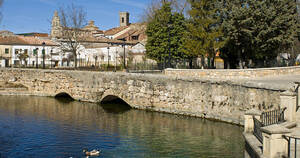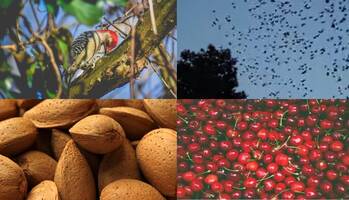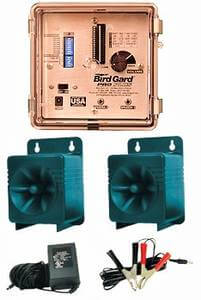Imagine you are a manufacturer, for example, of chairs. To make each chair, you have to cut the wood, polish it, varnish it… The process is slow, lasting a whole year, and you have to invest in materials. After a year of work, you manage to produce 100 chairs. But just when you are about to sell them and profit from your work and investment, thieves enter your factory and take away 60 of your chairs. And this happens every year… Wouldn’t you allow it? Wouldn’t you take measures to avoid losing 60% of your production?
Well, that’s what happened to José Luis López Budia. Although José Luis doesn’t manufacture chairs, he grows cherry and almond trees.

To know José Luis’s story, we have to go back to 2017, specifically to the winter of 2017. That year, José Luis decided to invest in a 2-hectare estate in Cifuentes (Guadalajara) to grow cherry and almond trees. In February of that same year, he started planting the trees.
José Luis’s estate is located about 2 km from the town center, surrounded by large poplar groves. It measures about 220 m long and 60 m wide, crossed by a stream that divides it in half. On one side of the estate, José Luis has cherry trees, and on the other side, he combines cherry trees with almond trees. In total, he has about 1,000 cherry trees and 800 almond trees.
Every year, José Luis sprays the trees, prunes them, waters them… Nowadays, he achieves a production of approximately 10,000 kilos of cherries and about 900 kilos of almonds.

However, it hasn’t always been this successful for him. José Luis has experienced seasons where his production has been reduced by 60% due to bird attacks. Specifically, starling flocks attacking his cherry trees, and woodpeckers targeting his almond trees.

José Luis remembers having to play detective until he discovered that woodpeckers were making holes in the almond kernels and extracting the pit. People in the village told him it could be mice eating the almonds. But José Luis knew that was impossible. Based on how they pecked, how they grabbed the clusters, and the height of the almond tree where they took them, José Luis was sure they had to be birds. One day, while working on the field, José Luis discovered a woodpecker hiding behind the trunk of an almond tree. The mystery was solved: it wasn’t mice but around 4 or 5 woodpeckers that were eating almost all the almonds.
Once José Luis had identified the thieves that were stealing 60% of his production, he decided to tackle the problem.
In the spring of 2018, he searched the Internet for a method to repel these bird species and discovered BirdGard Iberia. José Luis was unfamiliar with the company and didn’t know anyone who had used Bird Gard bioacustic repellers. In the village, some farmers used propane cannons in their vineyards, but José Luis knew they didn’t yield good long-term results.
The Bird Gard repellers seemed like a reliable method. However, what ultimately convinced him to purchase them was the guarantee offered by BirdGard Iberia, allowing him to try them for 30 days and return them at no cost if he wasn’t satisfied with the results.
BirdGard Iberia advised him to acquire 2 units of the BirdGard Pro Plus model. One of them dedicated to protecting the side of the crop with the cherry trees from starlings. And the other one dedicated to protecting the almond area from woodpeckers.
“Both bird repellers are identical,” explains José Luis. “The only thing that changes is the sound chip that each one comes with, and the sounds they emit. The bird repeller protecting the almond trees has Chip 11, and you hear distress calls from the woodpeckers themselves and predators. When the woodpeckers hear these calls, they believe that others of their species are warning them of danger and that they should stay away from the area, and hey, it works! Since we’ve had it, we haven’t lost any more almond production.
José Luis López Budia
In the Cifuentes area, the almond tree begins to bloom in mid-February. By early May, the almond kernel is milky with a green shell. That’s when the woodpeckers start pecking at the kernel. So, I start using the BirdGard Pro Plus with Chip 11 at the end of April and keep it until the end of June or July. I don’t harvest the almonds until October or November, but when the almond shell is already hard, the woodpeckers don’t attack them.
The bird repeller we have for protecting the cherry trees works the same way. The only difference is that this device is configured with Chip 61 and prevents starling flocks from devastating our cherry trees. In the Cifuentes area, starlings are common. They come in flocks of 200 to 300 specimens, and if they attack, they can destroy everything in a morning. The starlings used to attack my cherry tree a week before the harvest when the cherry was fully ripe.
I have the starling repeller in place from when the cherry starts to color until I harvest it, which is usually at the end of June or early July. I have the cherry trees trained in an espalier system, and they are about 1.80 meters tall. The speakers of the Bird Gard repeller are positioned at a height of about 2 meters, so the sound goes above the tree canopy.
The starling repeller also works wonderfully. Everyone in the village knows I have it. In fact, a neighbor who has a vineyard asked to borrow it, and I lent it to him to protect the grapes from starlings before the harvest, when I no longer need it.
To be honest, when I bought them, I didn’t think they would yield such great results. It has been a radical change. The deterrents weren’t cheap, but they have been a good investment that I recouped in the first year. And besides, it’s more enjoyable to work on pruning the trees, spraying them, and watering them when you know that birds won’t steal 60% of your harvest,” concludes José Luis.
If you want to learn more about deterring woodpeckers, we recommend reading the article “How to Deter Woodpeckers?“In our blog, you’ll find more customer references using BirdGard bird deterrents to deter thrush flocks, starlings, and blackbirds:
- Gobierno de La Rioja (Government of La Rioja)
- CSIC (Group of Viticulture of the Spanish National Research Council)
- Iberdrola

